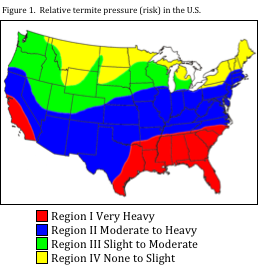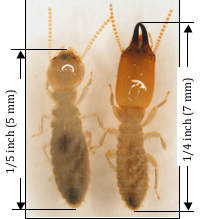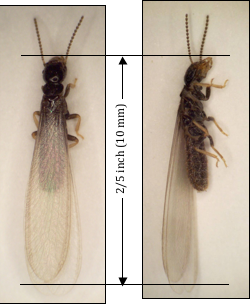Choosing a Pest Management Company to Protect Your Home Against Termites
Herein we discuss some questions that a home-owner can ask a pest control professional before hiring a company to prevent or control termites in their home.
Termites are severe wood-destroying insect pests present in all Oklahoma counties. They cause hundreds-of-millions of dollars of damage annually to wooden structures and homes across the United States. Termite pressure (risk) may range from very heavy in southeastern counties to moderate-to-heavy in the rest of the state. Generally, the farther north and west you are located in Oklahoma, termite pressure is less, north because of colder weather and west because of a drier climate (Figure 1).
Termites are soft-bodied, measuring approximately one-quarter-inch to one-half-inch long, creamy colored pale insects that consist of several different forms (castes). The different castes in a termite colony consist of the founding king and queen (primary reproductives that start a new colony), the wood-destroying form – workers, soldiers that defend the colony, and young, winged kings and queens (Figures 2 and 3). The winged forms (alates or swarmers; kings and queens) have two pair of wings that are nearly equal in length. When termites are swarming, this easily visible form is what homeowners call pest management professionals about. The wood-damaging workers are not usually visible unless their mud tubes or tunnels are broken open to expose crawling termites.
Figure 1. Relative termite pressure (risk) in the U.S.
Figure 2. Oklahoma native subterranean termites, worker (a) and soldier (b).
Figure 3. Oklahoma native subterranean termite swarmer (alate).
With termites, the thorax and abdomen are broadly connected, both about the same width, with a wide waist. That is, there is no narrowing or constricted waistline between these two body regions like that seen with ants. Bodies of termites are oval-tubular, not flattened. Figure 2 illustrates two castes, a worker and a soldier, showing body characteristics that are useful for identification. Figure 3 shows a top and side view of a winged termite swarmer (new reproductive).
Generally, subterranean termites must maintain contact with soil to survive. However, there are occasions where native subterranean termites can live above ground in structures and be completely cut off from soil contact, although this is not common. The probability that termites will attack a wooden structure within a few years after construction is high in Oklahoma. Termite attack could even begin within a year after construction because termites are everywhere in Oklahoma soils. Proper treatment of the soil with a liquid termiticide (insecticide formulated for termite control) before construction (pre-construction application) significantly reduces the threat from subterranean termites. If you know or suspect that your home is infested with termites, it is recommended the building owner retain the services of a professional pest control company. Termite management and termiticide applications require expensive specialized equipment, professional knowledge, and experience and training. This fact sheet reviews decision-making steps that will help you select a pest control company.
Homeowner Considerations
What do you do when termites are discovered in your house?
- Do not become overly alarmed.
- There is no need to become unduly alarmed if you learn that your home has a termite infestation. Termites work slowly so your house will not be quickly destroyed or collapse overnight. The termites have been present for several months or perhaps a few years, so taking a few days to determine your best termite management options is acceptable.
- Assess the situation.
- There is no need to allow anyone to rush you into purchasing termite management services. Take the time you need to make an informed decision. A delay of a few days or weeks will make little difference. There is always some time to consider and purchase a service knowledgeably and at your convenience. However, the quicker you make your decision, the less damage will occur.
- If you are not certain if termites are attacking your home or other wooden structure,
contact local pest control companies and discuss their termite inspection services
and treatment options.
- Arrange for a thorough termite inspection with the knowledge that prices for inspections, service estimates and payment terms can vary among companies. A proper inspection should include a short written report or inspection sheet that notes the location of areas damaged by either currently active or inactive previous termite infestations. Inactive infestation means that termites were previously active in a particular area of your house but termites were not present at the time of the inspection. The report should also include a description of how many and the type of treatments that will be made to eliminate the infestation. A diagram of your house should be included as this is helpful by indicating the location of structural features such as utility pipe accesses, porches, walkways and patios, and areas of wood-to-soil contact as well as areas with drainage or moisture problems in or near your home. An estimated total cost of liquid termiticide applications, or bait system installation, labor, and materials used should also be included. Determine whether the cost estimate is an agreed-upon set final price and be cautious if it is not. Feel free to seek a second opinion, quote or inspection, and inform each company involved that their competitors were contacted and what you have learned. Treat the professional company technicians with the same respect and courtesy you expect in return.
- Evaluate various treatment methods.
- Liquid termiticide applications to the soil are used to establish a continuous insecticide barrier between the structure and the termites tunneling in the soil.
- Existing concrete slab foundation houses normally require at least three types of
treatment: 1) treatment under the concrete floor slab, including porches or patios
abutting the house; 2) trenching and treating soil around the concrete slab perimeter
outside of and adjacent to the house; and 3) drilling and treating the void behind
the rock, concrete block, or brick veneer.
- Repellent or contact-toxic insecticides.
- The soil beneath the concrete slab floor perimeter inside the footer or stem wall must be treated. Treatment also may be required along both sides of interior support walls, next to interior partitions, and along all cracks and expansion joints in the slab if termites are found in any of these locations. Sometimes, it is necessary to treat the interior slab perimeter by drilling horizontally or at an angle from the outside through the exterior foundation walls. This method is often used to treat kitchens and bathrooms from outside the structure. Holes drilled in the slab can be spaced no further than 12-inches apart to achieve an effective, continuous barrier. The actual sub-slab treatment is accomplished by injecting the termiticide through drill holes in the concrete slab using a steel, hollow cylindrical rod inserted vertically through the pre-drilled holes.
- Trenching of soil requires excavating a 6-inch to 8-inch-wide by 6-inch to 8-inch-deep trench immediately adjacent to the outside foundation wall. Homes on pier and beam foundations are additionally trenched by excavating soil in a trench 6-inches to 8-inches-wide, by 4-inches to 6-inches-deep around all piers and utility pipes beneath the home as well as along inside and outside of foundation walls. Trenching is labor intensive and time consuming but provides a better, more continuous barrier than rodding alone. Make sure that all soil back-filled into the trench is treated. When trenching is not possible, treatment to soil is sometimes done by injection with the hollow rod alone. Additional sub-slab injections may be required for porches, patios, breezeways, driveways, and entryways where separate concrete slabs exist.
- Exterior (stand-alone) perimeter-only liquid termiticide treatments with termiticides
that are not repellent to or detectable by termites have become widespread and popular
with homeowners as well as pest management professionals.
- As of 2014, three termiticides are registered for use as exterior perimeter treatments that are accompanied by limited interior treatments when needed. When applied correctly, these termiticides are reported to provide effective termite control. An exterior perimeter treatment is less invasive than traditional liquid treatments to the soil that also require inside or outside drilling of concrete for sub-slab applications. If the structure is inspected and no termite infestation is found, this group of liquid termiticides can be applied to the soil around the exterior perimeter of the structure only. If the structure is inspected and found to have an interior live termite infestation, the soil beneath the concrete slab inside the structure must be treated in the area of the infestation. Label requirements as well as Oklahoma Law and Rules minimum standards must be met.
- Bait Systems.
- As of 2014 several manufacturers are producing baiting systems for management of subterranean termites.BASF manufactures the Advance® Termite Bait System; DowAgroSciences manufactures the Sentricon® Colony Elimination System and the Hex-ProTM Termite Baiting System; Ensystex manufactures the ExterraTM Termite Interception and Baiting System. The Advance, Sentricon, Hex-Pro, and Exterra systems utilize an insect growth regulator (IGR) as their active ingredient. One disadvantage of baiting systems is that they tend to have unpredictable time frames for effectively clearing out termites. Control may require two, three or up to six months and sometimes longer. Advantages of baiting systems include little risk of human exposure to pesticides and improved control in building areas that are difficult to treat with conventional liquid termiticide applications to soil (e.g., features such as sunken living rooms, damaged foundations, unusual high-value expensive floor coverings, and areas that have a history of non-successful treatments to soil). OSU does not recommend ‘do-it-yourself’ or ‘over-the-counter’ baiting systems. If you choose to use a baiting system around your home, hiring a pest control company experienced with these systems is recommended.
- Foam is used to apply termiticide to various construction features of a home.
- Foam formulations are used to reach and treat difficult to reach areas such as chimney bases, dirt-filled porches and inaccessible sub-slab areas. Insecticide-containing foams flow horizontally and vertically to reach inaccessible areas. However, foam is not suitable or effective for treating all of the soil under a structure directly, and most termiticide labels allow only a certain percentage of the total termiticide volume used to be applied as foam.
- Electronic and ultrasonic devices.
- No electronic ultrasonic frequency or similar devices, nor electrical current delivering devices have been scientifically proven to provide effective control of subterranean termites.
- Repellent or contact-toxic insecticides.
- Purchase pest management services from a reliable company.
- Termite management services should be purchased with the same care and discrimination you would use for any other service for your home and property. Be sure that you are dealing with a reputable company that is both licensed and certified to do the work and that also has an established physical business location.
- Oklahoma has published pesticide use and applicator laws that all commercial pest control companies must follow. Each company and each individual employee will carry an identification card issued by the Oklahoma Department of Agriculture, Food and Forestry (ODAFF) listing their pesticide applicator certification categories.
- Check on pest control association membership.
- Membership in the Oklahoma Pest Control Association is evidence that a company has an established place of business, ascribes to a code of ethics, and has access to technical literature for training and consultation. The membership list of this association may be obtained by writing directly to: President, Oklahoma Pest Control Association, P. O. Box 6954, Edmond, OK 73083-6954 (405-726-8773), or check their web address: www.ok-pca.com.
- Things to remember:
- If a company offers references of previous work, take time to contact these references.
- If the company is located in your town or city, make sure it has an established place of business. This can be checked through the Chamber of Commerce, Better Business Bureau, the Oklahoma Department of Agriculture Food and Forestry, or a street address in the phone book.
- If a company street address or phone number is from out-of-town, or is a P.O. Box or UPS-store type of address, it is even more important that you make sure it is dependable, local company. Check that it has an established place of business in the town where it claims to be located.
- Ask for references and take the time to check them out.
- Beware of companies that:
- Quote a price based on the gallons of material used.
- Profess to have a secret formula or ingredient for termite control. All termiticides must be registered by the U.S. Environmental Protection Agency; there are no secret formulas.
- Do not have a telephone number and street address listed in the phone book.
- Show up unexpectedly and use evidence of termites in trees or other nearby houses as an excuse to inspect your house or provide you a service.
- Use high-pressure, emergency, scare-tactic sales methods.
- Want to trim trees and do general foundation repair work as part of the “deal.”
- Cater to elderly or infirm people who live alone. Relatives and neighbors should warn elderly people to beware of persons who knock at the door and propose to do service work, including treating their house for termites, and may also want advance payment for the proposed future services.
- Claim to be endorsed by Oklahoma State University or any other university or state agency.
- Claim to have excess chemical left over from another job and offer a reduced price if they can do the treatment immediately.
- Use alarming terms, stating you must receive a treatment immediately to avoid great damage.
- Become knowledgeable of the structural pest control requirements governing inspections
and treatments. Inspections conducted to establish the need for treatment may be made using a company’s
own form, or using Oklahoma’s ODAFF 1 form. A home or building inspection made for a property sale real estate type transaction
must be made on the ODAFF 1 form.
- Before conducting atermiticide application or installing a termite baiting system,
the pest control company proposing the treatment must present you with a disclosure
statement that contains the following information:
- Graph or sketch and written description of the structure or structures to be treated, clearly showing areas with currently active termites or previous termite damage.
- The name of the pesticide(s) to be used along with the label for the termiticide.
- Complete details of the warranty provided, including:
- Areas excluded from treatment, if any;
- Warranty time period;
- Renewal option(s) and cost(s);
- Obligations to re-treat or repair damage caused by termites within the warranty period;
- Conditions that could develop as a result of the owner’s action or inaction that could void the warranty; and
- Signature of approval by a certified applicator.
- Before conducting atermiticide application or installing a termite baiting system,
the pest control company proposing the treatment must present you with a disclosure
statement that contains the following information:
- Know the terms of your contract. Ask your termite control specialist to provide a detailed written statement of the work they propose to do and an estimate of its cost. They will give you time to consider their estimate. It is customary to provide a warranty on termite management work, either on a year-to-year basis or for a longer period. It is a good idea to plan on extending your warranty for at least 2 or 3 years after the treatment. Make sure you know the terms of the warranty offered. Compare warranties carefully. A warranty is a guarantee of service, not a guarantee of an effective termite barrier. Warranties that vaguely refer to termite control are not acceptable. Determine whether a yearly charge will be levied during the warranty period, or whether these charges are included in the initial price. Find out how much it will cost to extend the warranty for additional years and ask how long it can be extended. Remember that a warranty is no better than the person or company who gives it to you. A warranty is not evidence that a company is dependable. Make sure you get copies of the contract and any warranties for your records. You will probably be asked to sign a work order or contract when you hire a company and pay for services up-front. Clearly understand what obligations you are assuming and what you will receive in return. As required by law, the contract must include its terms and conditions in writing. It includes but is not limited to warranties or guarantees for structural pest control applications. The contract shall also include a statement, plat, or diagram showing all locations of currently active termites and termite-damaged materials and locations that were observed, and details such as trenching and rodding soil locations around and under a structure, clearly explaining methods of how the application was performed.
Information Websites
Oklahoma State University
Pesticide Safety Education Program: www.pested.okstate.edu
Oklahoma Department of Agriculture Food & Forestry: http://www.oda.state.ok.us/cps.htm
Oklahoma Pest Control Association: http://www.ok-pca.com
National Pest Management Association: http://www.npmapestworld.org



